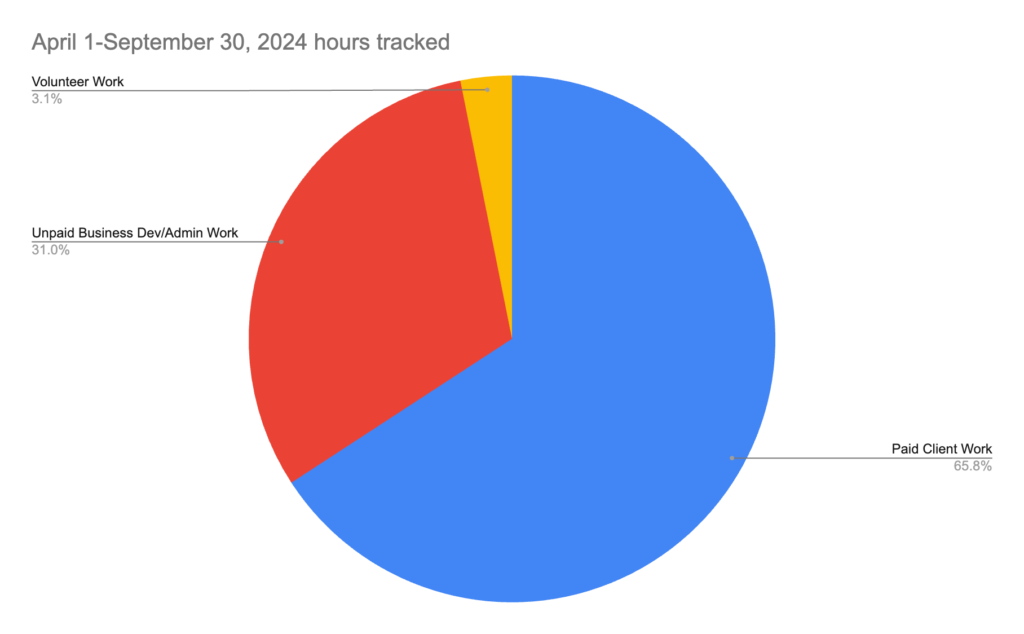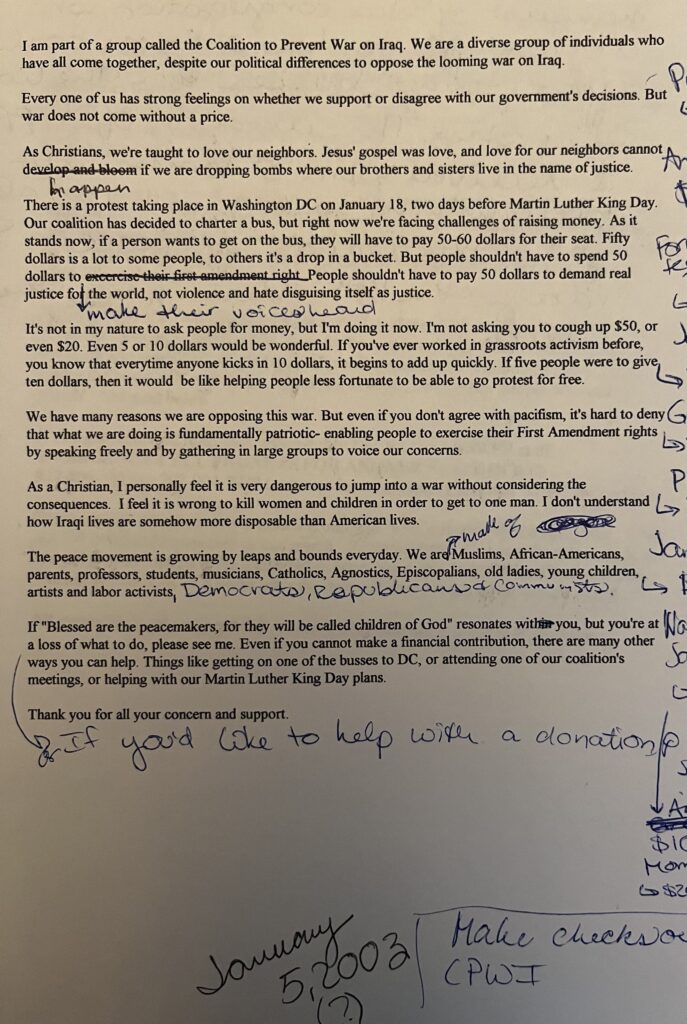Time Sheets: April 1-September 30, 2024
Back in June I wrote about how my relationship with time has changed since I transitioned into self-employment. Reflecting further on this topic, something that’s worth highlighting is how much self-employment revealed the kinds of temporal conditions that I need for productive work. For years at my previous salaried position, I despaired over how difficult it was for me to move forward on many projects. On an intellectual level, I knew that working five days a week on-site in an office that faced constant interruptions and where I was often forced to put out fires of others’ making probably had something to do with feeling like I could never get anything done. My previous position basically had me working in on-call circumstances while expecting me to accomplish deep cognitive work–the exact kind of work that is not conducive for an environment with constant interruptions. But it really took working for myself–where I could control many of the external disruptions–to realize that I wasn’t broken and incapable of doing deep work. I can do a lot of deep work when I am not constantly battling interruptions.
Here is the other thing that I’ve had to unlearn, and it’s hard because even a committed socialist like me has a lot of internalized capitalism: I’ve had to let go of the idea of the 40-hour work week as a proxy for “productivity.” As I laid out in the last post, running a business means not just doing the work that gets you paid (i.e., billable work for clients), but lots and lots of unpaid work you need to do to keep the business running.
There is emerging research and self-reported anecdotes from knowledge workers showing that most individuals engaged in cognitive work have an upper limit to how many “productive” hours they have in a given day. In other words, most people are not only not actually working a “productive” 40 hours a week, most of them cognitively cannot perform deep work for more than 3-5 hours a day, even with ideal circumstances. Trying to do 40 hours of paid client work a week on a regular basis is a fast path to burnout, because then you would have to spend many more hours on top of 40 weekly in order to handle non-billable tasks. For example, AIIP advises allocating between 30-50% of your working hours for the overhead work of running your business.
Indeed, my own meticulous time-tracking I’ve undertaken since transitioning to self-employment underscores that there is a maximum limit to how much work I can do while ensuring I don’t accidentally replicate the cognitive exhaustion (and resentment, and anger, and lack of time for involvement in hobbies) that I routinely experienced in my previous salaried role. This has been super eye-opening. Since self-employed people love to compare numbers, I thought it would be helpful to break down what my average working time looks like, measured across six months. As with all self-employed stuff, assume the usual caveats, disclaimers, and gentle reminders that my numbers may not look like other’s numbers. I feel pretty self-conscious about sharing these numbers. I don’t know if it’s survivor guilt that I’m not grinding as hard as I used to, but I also know that my health and well-being is phenomenally much better right now since I can determine my own working pace.
I use Moxie1 for time-tracking all of my paid work, and much of my unpaid work. I exported all of my time tracking data from April 1, 2024 through September 30, 2024. Here are some of the major highlights of that time period:
- I maintained a heavy workload with an ongoing major client, a second new major client, and engagements with several one-time client projects (speaking engagements, workshops, teaching, etc)
- In March I was still recovering from being hospitalized for appendicitis and my father passing away, but was slowly getting back to normal work capacity
- In April I traveled to Florida to see extended family
- In May I had my interval appendectomy
- Over the summer I finished my service on the National Archives Freedom of Information Advisory Committee and was elected to the Society of American Archivists Council
- In late summer, my mom was hospitalized multiples times due to a post-surgery infection and I provided significant support to her and my stepfather
- I attended the Society of American Archivists (August) and Council of State Archivists (September) annual meetings
- I had some other minor health and household things come up that while not catastrophic, were generally annoying and took time and energy to deal with that I would have rather used on literally anything else
Here is how the overall numbers shook out:
| Type | Duration (hh:mm:ss)2 | Monthly Average (hh:mm:ss) | Percentage |
| Paid Client Work | 344:01:45 | 57:20:18 | 65.81% |
| Unpaid Business Dev/Admin Work | 162:18:48 | 27:03:08 | 31.05% |
| Volunteer Work | 16:26:35 | 2:44:26 | 3.15% |
| Grand Total | 522:47:08 | 87:07:51 |
For those of you who like things visually represented, here’s a pie chart:

In some ways, the volunteer work is a bit underreported, because this represents only major current ongoing service commitments, such as my Society of American Archivists Council work, and some of my previous ongoing service work was counted under unpaid business dev/admin work. I strongly expect that this number is going to increase in the future, given that I only just started my Council role a few weeks before the end date of these numbers. Until I was elected to Council, I used to count professional service/volunteer work as part of my general unpaid overhead work, but given the major time commitment of being an SAA Council member, that’s why I recently designated SAA Council work as a totally separate time-tracking category.
Are you curious about how the 162 hours of unpaid overhead/business development/administrative work shakes out? I have those numbers as well!
| Memory Rising Overhead/Biz Dev/Admin/Service | Duration (hh:mm:ss) |
| 2024 Accounting and Admin | 35:24:44 |
| 2024 Business Development | 44:20:28 |
| 2024 Professional Development | 21:20:01 |
| 2024 Professional Service | 19:07:19 |
| New Deal podcast | 42:06:16 |
| Grand Total | 162:18:48 |
Here’s a little explanation of what’s in each category:
- Accounting and administration:
- Updating my bookkeeping and receipts in Quickbooks
- Calculating quarterly estimated taxes
- Reviewing what tasks/projects I have to do over the next week/month
- Triaging my email inbox
- Business development:
- Working on my newsletter
- Updating my website
- Attending mostly virtual and sometimes IRL networking coffees/meetups
- Professional development:
- Attending webinars
- Meetings with a mentor
- Identifying grants/fellowships I may be eligible for
- Professional service:
- Media interviews
- FOIA Advisory Committee meetings
- ALA/SLI National Climate Action Strategy for Libraries
- Society of Ohio Archivists newsletter column
- New Deal podcast:
- This is not yet off the ground but it’s a huge goal to launch it in the first half of 2025. Until I a) establish that it’s a project I want to commit to long-term and b) find a funding model for its longevity, I’m counting it as part of my business overhead until I can justify breaking it out into its own category.
- Disclosure: this is a free trial affiliate link that gives me a small payment if you try out Moxie. I’m not paid by the company, I’m just a big fan of the software. It’s not perfect, but it meets most of my time tracking/scheduling/project management/proposal drafting needs, and I’ve been using it almost since I started working for myself. ↩︎
- hh:mm:ss means hours:minutes:seconds ↩︎











